The Meaning Behind Engagement Ring and Wedding Band Sets
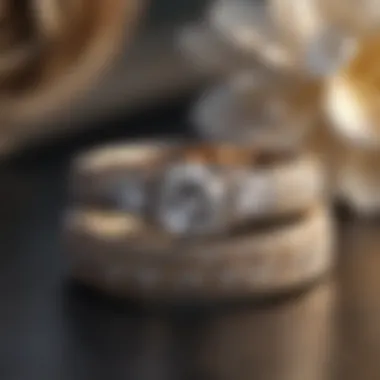
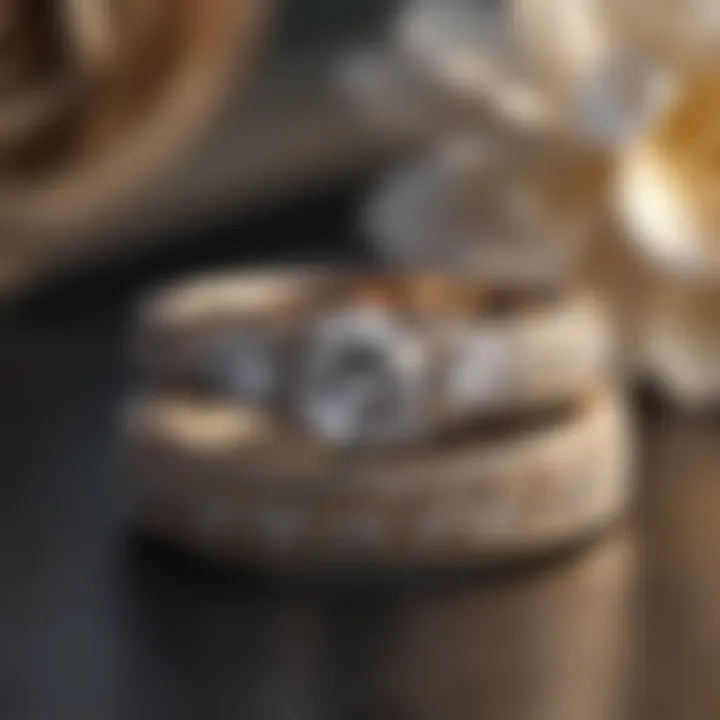
Intro
Engagement rings and wedding bands are more than just beautiful pieces of jewelry; they embody deep emotional connections and serve as symbols of commitment. Each set tells a unique story about love, history, and personal style. This article aims to uncover the layers behind these rings, guiding both newcomers and seasoned collectors through their significance, styles, and how to choose the right ones.
Gemstone Overview
Definition of Gemstones
Gemstones are naturally occurring minerals that have been cut and polished for use in jewelry. They come in various colors, shapes, and sizes, each possessing distinct qualities that make them desired by gemstone enthusiasts. Often, their value is determined by a combination of rarity, beauty, and durability.
Classification of Gemstones
Gemstones can be classified into two main categories: precious and semi-precious. Precious gemstones include diamonds, rubies, sapphires, and emeralds, known for their brilliance and perceived scarcity. On the other hand, semi-precious stones, such as amethyst, aquamarine, and garnet, while lovely, are typically more abundant, making them more accessible for a broader audience.
- Precious Gemstones:
- Semi-Precious Gemstones:
- Diamonds
- Rubies
- Sapphires
- Emeralds
- Amethyst
- Aquamarine
- Garnet
- Citrine
Historical Significance
Origins of Gemstone Use
The use of gemstones can be traced back to ancient civilizations where they were not just utilized for adornment but were believed to hold magical and protective properties. For instance, in ancient Egypt, turquoise and lapis lazuli were favored by royalty and were often placed in tombs for the afterlife. Gemstones were seen as a direct link between the earthly realm and the divine.
Cultural Insights: Gemstones in Ancient Civilizations
In cultures around the world, gemstones had various significances. In India, the astrology of gemstones played a vital role; certain stones are believed to influence the wearer’s fate. The Greeks often associated stones with specific gods. For example, the opal was linked to the goddess of love, Aphrodite. These rich histories shape today’s choices in engagement rings and wedding bands, connecting wearers to a broader narrative of love that transcends time and culture.
"Gemstones have always represented more than beauty; they embody stories of our ancestors, their beliefs, and the emotions we've inherited." – Unknown
Historical Context of Engagement and Wedding Rings
The historical context surrounding engagement rings and wedding bands is rich and varied, deeply intertwined with cultural practices and beliefs across the globe. Understanding this background isn't just a matter of curiosity; it provides a lens through which we can see how societal norms and values shape the way we perceive and celebrate love and commitment. From ancient traditions to modern practices, the journey of these rings is a testament to their evolving significance as symbols of partnership.
Origins of Engagement Rings
The tradition of giving an engagement ring can be traced back to ancient Egypt, where rings made of braided reeds or leather were exchanged between couples as a sign of commitment. These signs of devotion were thought to symbolize eternity; the circle of a ring has no beginning or end, much like the love between partners. The practice then carried over to Rome, where brides received rings made of iron, representing strength and permanence. It wasn't until the Middle Ages that diamond engagement rings became fashionable, notably thanks to Archduke Maximilian of Austria, who gifted a diamond ring to Mary of Burgundy in 1477. This extravagant gesture set a precedent, encouraging the belief that a woman's worth was shown through the size and quality of her engagement ring. Over time, diamonds became regarded as the ultimate symbol of love and fidelity, deeply cementing their place in modern engagements.
Evolution of Wedding Bands
Wedding bands have a history steeped in symbolism and rituals. The ancient Romans were known to exchange simple metal bands at their weddings, often made from materials like iron or gold. These bands represented not just love, but also the bond of trust and security between spouses. The medieval period saw the introduction of more intricate designs, often embellished with engravings or gemstones to signify the unique partnership.
In many cultures, the wedding band is worn on the fourth finger of the left hand, believed to contain a vein that travels directly to the heart, further tightening its association with love. Over the centuries, those rings have evolved from basic designs to elaborate pieces, influenced by fashion trends and the rise of bespoke jewelry craftsmanship.
Today, there’s a significant emphasis on personalization, reflecting individual styles and story. Matching sets of engagement rings and wedding bands help couples express their unity while also allowing room for personal flair.
"Rings are not just mere ornaments; they embody stories, cultures, and the deep-rooted emotions of those who wear them."
Overall, knowing the historical context of these rings enhances appreciation for their role in contemporary society. From their origins as simple bands of grass in ancient cultures to the lavish diamond-studded pieces we see today, engagement rings and wedding bands serve as timeless tokens of commitment, marking the transitions of love through the ages.
Symbolism Behind the Rings
Engagement rings and wedding bands are more than just pieces of jewelry; they are profound symbols of love, commitment, and tradition. When two people choose their rings, they are not only selecting a piece of art but also embodying their relationship's essence. This section delves into the symbolism behind these rings, emphasizing both cultural significance and personal meanings that may vary from couple to couple.
Cultural Significance
Different cultures have unique traditions surrounding engagement rings and wedding bands. In many Western societies, for example, diamond engagement rings have become a standard choice, a trend that began in the mid-20th century. This trend emphasizes that the diamond symbolizes durability and timelessness, perhaps to mirror the union being formed.
In some cultures, like Indian traditions, there’s a significant emphasis on gold. Gold wedding bands are prevalent as they connote wealth, prosperity, and security—both materially and emotionally. Notably, the circular shape of the rings themselves also has a strong message; circles have no end, representing the never-ending nature of love and commitment.
"A ring is a circle, and for a moment, time does not forward, nor does it go back; it simply is, like love in its purest form."
Moreover, if we peek into various cultures, we find that specific gemstones are chosen for their believed mystical properties. For instance, sapphires are associated with fidelity and nobility, making them a popular choice among couples who wish to highlight these values in their relationship. As you can see, cultural significance is layered and varies with one’s background, making the choice of an engagement ring or wedding band deeply personal and reflective of broader societal values.
Personal Meaning
When it comes to personal meaning, the rings often tell a story unique to the couple. Each person imbues their ring with emotions that resonate at a personal level. For some, it may symbolize the moment they decided to commit, encapsulated in the very design of the ring. Others use it as a reminder of a shared adventure, embedding personal milestones or symbols that reflect shared interests.
A lot of couples are opting for custom designs that tell their unique love story, sometimes even incorporating family heirlooms. This adds another layer to the meaning, as these rings are not just contemporary pieces but also connections to the past.
Furthermore, the choice of material—be it platinum, gold, or silver—entails personal significance too. Some couples lean towards platinum for its durability and rarity, while others might favor gold for its warmth and classic nature. The emotional connection can often overshadow the mere aesthetic value of the rings; they can represent vows made, promises kept, and the life built together.
In summary, understanding the symbolism behind engagement rings and wedding bands opens up a street filled with rich, multifaceted meanings that resonate across cultures and personal experiences. By diving into the cultural significance and personal meaning behind them, we can appreciate how these seemingly simple bands embody the intricacies of love and commitment.
Choosing the Right Set
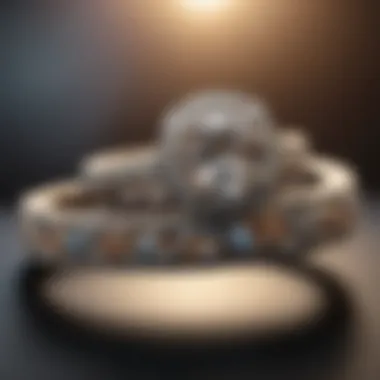
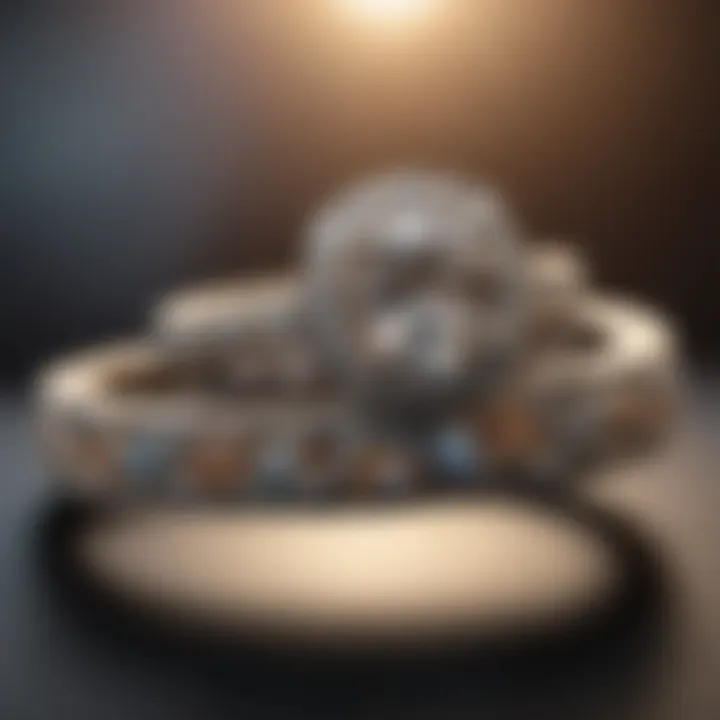
Selecting the right engagement ring and wedding band set is more than just a matter of aesthetics. It weaves together threads of personal taste, cultural significance, and emotional narrative. This part of the article addresses the importance of overall harmony between the two rings and how they can symbolize a couple’s journey
An ideal set reflects the individuality of the wearers while also striking a balance between style and comfort. Below, we explore various styles that allow couples to find what resonates with their unique love story.
Engagement Ring Styles
Solitaire
The Solitaire engagement ring style stands as a timeless testament to simplicity and elegance. This type features a single gemstone, usually a diamond, which serves as the focal point. Its straightforward design draws the eye to the stone’s brilliance and purity, representing the undivided commitment between partners.
One key characteristic of the Solitaire ring is its versatility, making it suitable for any type of wedding band. This adaptability is particularly beneficial for those who want to mix and match styles without worry. However, the drawback is that the single-stone focus may not appeal to those who prefer more elaborate designs. Nevertheless, its classic nature makes it a popular option.
Three-Stone
The Three-Stone engagement ring is another captivating option. This design typically features a center stone flanked by two smaller stones, which can be interpreted as a representation of the past, present, and future of the couple's relationship. The symbolism is deeply meaningful, and couples often choose stones that hold significance for them.
A notable trait of the Three-Stone style is its ability to combine various gemstones and metals. This flexibility is a real selling point for those wanting to add a personal touch. Some may find, however, that its complexity can overshadow the central stone, which may not speak to minimalists.
Vintage
Vintage engagement rings, with their intricate designs and unique features, invoke a sense of nostalgia and romance. Drawing inspiration from past eras, they are often embellished with filigree, engravings, or intricate settings. These rings stand out for their artistry, appealing to those who appreciate craftsmanship that tells a story.
One significant advantage of choosing a Vintage style is the potential for rarity; the charm and individuality of these rings can mean that they will not be repeated. On the downside, their irregularities might not appeal to everyone, especially those who are seeking a more modern aesthetic.
Wedding Band Designs
Classic
A Classic wedding band embodies the essence of enduring love. These rings are typically unadorned or minimally designed, symbolizing a commitment that's as steady as the metal itself. Their simplicity allows them to blend seamlessly with various engagement ring styles, creating a harmonious look.
The most notable characteristic of Classic bands is their timeless quality, making them a favored choice for many couples. However, some may find them too plain or traditional for their tastes, lacking the personal touch that a more elaborate design might provide.
Matching Sets
Matching Sets have grown in popularity due to their coordinated beauty and symbolism. These rings are designed to complement each other, creating a unified appearance that signifies a couple’s shared journey. Many couples appreciate the effortless style that comes with a matching set, eliminating the guesswork involved in coordinating two rings on their own.
Yet, while these sets often represent harmony, they may limit the individual's expression in choosing a unique engagement ring that speaks to their personal style. Thus, it’s essential to weigh the benefits of synchronicity against the desire for individuality.
Custom Options
Custom wedding bands present endless possibilities tailored to the couple’s preferences. Crafted specifically for the wearer, these pieces can integrate personal elements like initials, significant dates, or even unique design motifs. This tailored approach ensures that the ring holds a special significance.
The main advantage of Custom Options is their exclusivity. They allow couples to create something truly unique that reflects their love story. However, they can often come with a higher price tag and require extra time for design and crafting. For those seeking a special touch, the investment can be more than worth it.
In sum, choosing the right set of engagement and wedding rings hinges on personal taste, lifestyle, and the deeper meanings attached to symbols of commitment. A well-chosen set is more than mere jewelry; it's an embodiment of a couple’s love, capturing both their present moments and future dreams.
Factors to Consider When Selecting a Set
Choosing an engagement ring and wedding band set is not just a shopping spree; it's about finding a symbol that represents your unique journey together. When selecting a set, there are several factors to keep in mind that can make or break your choices. It’s not simply about picking something that looks good; it should align both with your personal preference and practical considerations. Understanding what to look for can help you avoid buyer's remorse and ensure a satisfying purchase.
Budget Considerations
Setting a budget is generally one of the first steps in this process. Engagement rings and wedding bands can range from a couple of hundred dollars to several thousand. Think about what you are comfortable spending, but don’t just settle for the lowest price. Sometimes, a bargain can lead to poor quality, which is not what you want.
- Evaluate your financial situation. Take a long, hard look at your finances and decide what you can afford without getting into hot water.
- Research average prices. Websites can help you gauge what other people are spending, but remember to factor in your local market conditions.
- Consider financing options. Some jewelers offer payment plans, which can ease the immediate financial burden.
A well-thought-out budget is like a compass that points you in the right direction, ensuring that you don’t overspend while still finding something beautiful.
Metal Choices
Metal choice is another critical aspect that influences not only the appearance but also the longevity of your rings.
Gold
Gold has been a popular choice for centuries due to its luster and timeless appeal. Its key characteristic is its malleability, and it can be crafted into various designs without compromising strength.
- Benefits: Gold rings can be easily resized and are available in a range of colors: yellow, white, and rose. This means you can customize the look to your taste.
- Unique Features: One peculiar aspect of gold is its karat system, which denotes purity. A 24k gold ring is pure gold but may not be the best for everyday wear.
- Advantages: Offers various color options.
- Disadvantages: 18k or 14k gold rings, while more durable, may not have the stunning appeal of higher karat options.
Platinum
Platinum often steals the show in the world of fine jewelry, especially for wedding bands. It boasts a significant key characteristic of being incredibly durable and dense, which means it will withstand the test of time.
- Benefits: Platinum jewelry maintains its luster for a longer period than gold and doesn’t tarnish, making it a beneficial choice for those worried about wear and tear.
- Unique Features: The weight of platinum can cause it to feel more luxurious on the finger, which some people love.
- Advantages: Its hypoallergenic properties make it ideal for sensitive skin.
- Disadvantages: Because it’s rarer than gold, it often comes with a heftier price tag.
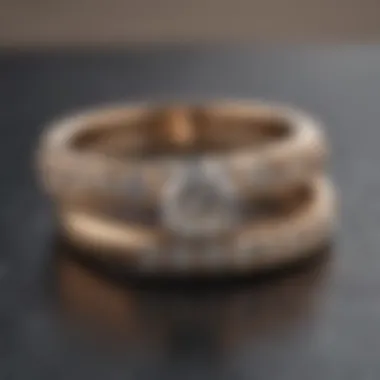
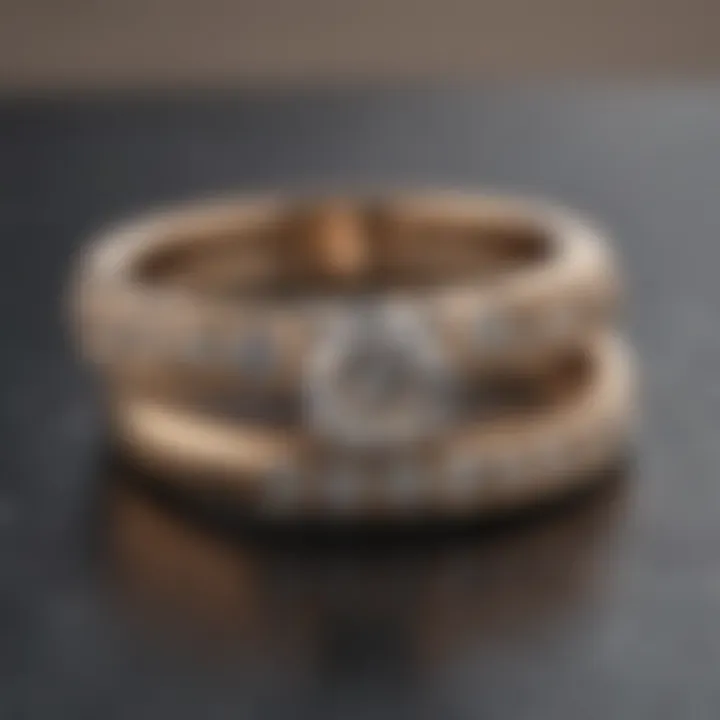
Silver
Silver rings, while beautiful, are often overlooked in comparison to gold and platinum. The key characteristic of silver is its shiny finish and affordability, making it a popular choice for couples on a budget.
- Benefits: Silver can easily be polished to restore its shine and is readily available, making it a practical option.
- Unique Features: Unlike gold and platinum, silver can tarnish, which requires regular maintenance.
- Advantages: Lightweight and easy to wear daily.
- Disadvantages: Lower durability when compared to gold or platinum, leading to possible dents or scratches.
Ultimately, choosing the right metal comes down to personal preference and lifestyle. Each has its own merits, but where your heart lies will greatly influence your choice.
Gemstone Options and Their Properties
Selecting the right gemstone for an engagement ring or wedding band can be as vital as choosing the design itself. While diamonds have long held the crown in popularity and symbolization, an emerging trend highlights a range of alternative gemstones that offer both beauty and distinct personal significance. Understanding the properties of these gemstones is crucial, as it shapes the aesthetic appeal and overall durability of the rings. Different stones carry unique characteristics, giving couples the opportunity to express their individuality through their choices.
Diamonds and Their Grades
When it comes to classic engagement rings, diamonds remain an undisputed champion. But choosing a diamond isn’t just about picking one that shines. The grading of diamonds often focuses on four essential factors, which can be commonly remembered as the "Four Cs": Cut, Color, Clarity, and Carat weight.
- Cut: This aspect determines how well a diamond reflects light. A well-cut diamond can appear more brilliant than a larger one with a poorer cut.
- Color: While some may imagine diamonds as purely clear, they come in a variety of colors. Generally, colorless diamonds, rated D, E, and F, are considered most valuable.
- Clarity: This grade indicates the presence of imperfections. A higher clarity rating means fewer flaws, which typically increases pricing.
- Carat: This refers to the weight of the diamond. Larger stones are often more expensive, but beauty can come in all sizes.
The interplay of these factors can significantly affect the price and the visual appeal of a diamond, making it essential to understand them when making a purchase.
Alternative Gemstones
If you find diamonds don’t fit the bill for you, there's a treasure trove of alternative gemstones that insightfully blend beauty, rarity, and meaning. Let’s explore some popular choices:
Sapphires
Sapphires are among the most sought-after alternatives to diamonds. While often associated with deep blue hues, they are available in an impressive array of colors, including yellows, pinks, and even greens.
- Key characteristic: Their durability makes them an excellent option; sapphires rank a sturdy 9 on the Mohs scale of hardness.
- Unique feature: Their color variety allows for personal expression in rings that can reflect the wearer's identity or passions.
- Considerations: While stunning, it’s essential to be cautious of heat treatment, which is a common method to enhance the color. This typically raises questions regarding the stone’s value and authenticity.
Emeralds
Emeralds, known for their stunning green hues, carry a rich historical significance, often linked with renewal and rebirth.
- Key characteristic: They possess a unique, vibrant color that catches the eye, offering a stark contrast to traditional diamond choices.
- Unique feature: However, while beautiful, emeralds are softer compared to other gemstones, ranking 7.5 to 8 on the Mohs scale. Given this, they do require a tad more care in terms of usage and maintenance.
- Considerations: Natural emeralds commonly contain inclusions, known as "jardin"; while some shoppers might see this as a drawback, others perceive it as an essential part of the stone's character.
Moissanite
Moissanite has gained traction as a diamond alternative due to its remarkable brilliance and fire. Discovered in 1893, it’s now synthesized for jewelry, making it a more ethical choice.
- Key characteristic: The stone shares a sparkle that often surpasses even the finest diamonds; it is rated 9.25 on the Mohs scale.
- Unique feature: Unlike diamonds, moissanite maintains its sparkle and brilliance when faced with environmental factors.
- Considerations: While more budget-friendly than diamonds, some folks may still associate it with less prestige compared to a traditional diamond. However, their quality and beauty stand solidly behind the choice.
Choosing the right gemstone can be a journey through personal preferences and symbolic meanings. This choice represents not just a piece of jewelry but rather a part of your story, encapsulated in the beauty and significance of the jewel you wear.
The Importance of Quality Assurance
Ensuring quality in engagement ring and wedding band sets is paramount, not only for the aesthetic appeal but also for the longevity and value of the piece. When couples embark on the journey of selecting these symbols of love, understanding the quality factors can make a significant difference in satisfaction and investment.
Quality assurance encompasses more than just the materials used; it includes the craftsmanship, ethical sourcing, and the overall integrity of the jewelry. With many options available, discerning buyers need to know what to look for. The right piece reflects not just beauty, but also the care invested in its creation, thereby capturing a momentous occasion in a lasting way.
Certifications and Grading Reports
Certifications provide a verified check against quality claims made by jewelers. They serve as a language of trust between buyers and sellers. For instance, diamond certificates from reputable organizations like the Gemological Institute of America (GIA) or the International Gemological Institute (IGI) play a crucial role in establishing the quality of gemstones.
Each certification consists of essential details regarding the gemstone, including:
- Cut: The quality of the diamond's cut influences its brilliance.
- Color: Ranges from colorless to light yellow, impacting value and appearance.
- Clarity: Refers to imperfections; the fewer imperfections, the higher the quality.
- Carat Weight: Indicates the size of the diamond, relevant to its value.
Having these reports at hand offers peace of mind. It's like having a detailed travel guide for a journey—you don’t just set off without knowing the terrain.
Evaluating a Jeweler
The choice of jeweler is equally significant. A trustworthy jeweler guarantees that the quality assurance checks are in place from the get-go. Here are several aspects to keep at the forefront:
- Reputation: Research and reviews online can provide insights into a jeweler's track record. Websites like Reddit or community forums can be useful for genuine feedback.
- Certifications: Ensure that the jeweler can provide the relevant certificates for gems and metals, thus confirming their claims.
- After-Sales Service: Quality assurance doesn't end at the sale. A good jeweler offers services such as resizing, repairs, or maintenance, which adds to the overall value of the purchase.
- Transparency: A reputable jeweler should have no problem discussing their sourcing practices, gemstone origins, and providing clear pricing information without hidden fees.
"In the world of jewelry, the jewelers hold the key to quality, ensuring what glitters is indeed gold or diamond."
Investing the time to thoroughly vet both stones and the professionals behind them can result in a piece that not only serves as a beautiful accessory but also stands the test of time—both in terms of style and durability.
Trends in Engagement and Wedding Rings
In the realm of jewelry, trends in engagement and wedding rings not only reflect current fashion but also encapsulate broader shifts in societal values and personal expression. As couples navigate their unique journeys, these trends serve as significant markers of their identities. Understanding these trends is vital for future buyers—they can provide insight into what's available, guide selections that resonate personally, and illuminate evolving cultural standards around commitment.
Contemporary Styles
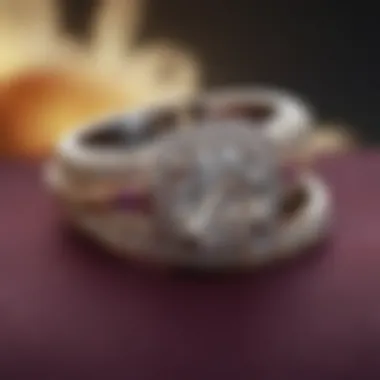
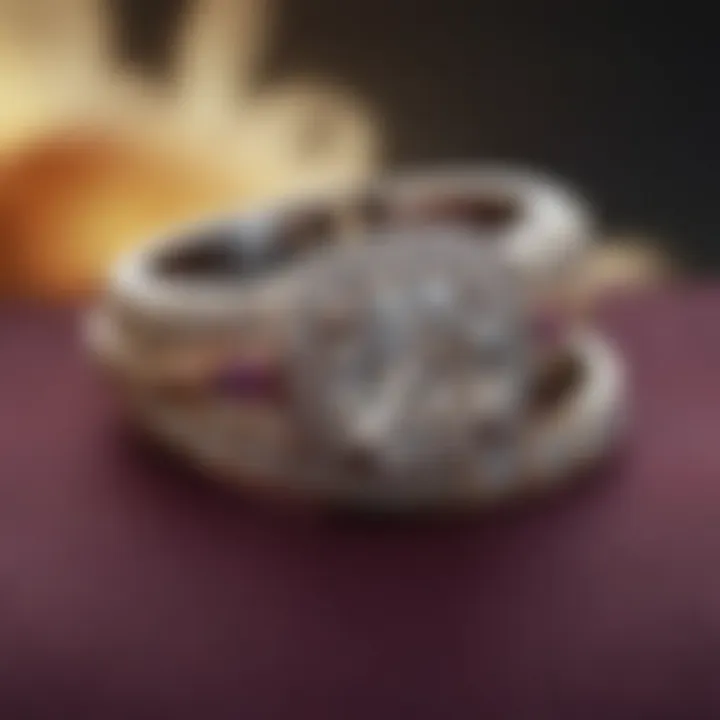
Contemporary styles have emerged as a leading trend in engagement and wedding rings. These designs often reject traditional aesthetics for something fresh and individualistic.
- Minimalism: The "less is more" approach often speaks to modern couples. Sleek lines and unobtrusive settings offer a refined elegance. The focus is often on the quality of materials rather than embellishment.
- Mixed Metals: Gone are the days of sticking with one metal type. Combining rose gold with platinum or yellow gold offers a unique visual appeal. This approach enables couples to express their uniqueness and personal style.
- Unexpected Shapes: Rings that depart from the classic round cut are gaining traction. Shapes like ovals, pears, or even asymmetrical designs defy conventions. This trend awards couples a chance to showcase their individuality—setting them apart from the crowd.
- Statement Stones: Many couples opt for colored gemstones or unconventional diamonds. This shift signifies a departure from the traditional white diamond center stone. Choices like sapphires, emeralds, or lab-created diamonds often carry their own histories and stories.
"Your ring should tell your story—why follow the herd when you can carve your own path?"
Ultimately, contemporary styles cater to an audience that values authenticity and self-expression. It’s liberating to see how such designs resonate with couples wanting a reflection of their love story.
Sustainability and Ethical Sourcing
In recent years, the conversation surrounding sustainability and ethical sourcing has entered the jewelry industry with full force. An increasing number of consumers are consciously considering the environmental and social impact of their purchases. This not only reflects personal ethics but also a desire to contribute to a more responsible world.
- Eco-Friendly Materials: Couples are increasingly seeking rings made with sustainable materials. Recycled metals or ethically sourced gemstones are hot commodities. This trend places value on responsibility and integrity, allowing couples to feel good about their choices.
- Lab-Created Diamonds: Lab-grown diamonds have surged in popularity, providing a conflict-free alternative to traditional diamonds. These options have the same physical and chemical characteristics, yet they often come at a lower price point without the ethical quandaries.
- Supporting Artisans: Shopping for rings from local artisans or fair-trade jewelers fosters a more durable economy and strengthens communities. Couples find value in connecting with creators whose ethical practices align with their values.
- Transparency in Sourcing: More jewelers are being transparent about where their materials come from. This shift is essential, as it allows consumers to make educated decisions regarding their purchases, promoting advocacy for responsible mining practices.
In essence, as couples become more conscious of their impact, trends in sustainability and ethical sourcing in engagement and wedding rings will only continue to expand. Not just a beautiful piece of jewelry, these rings can embody a commitment to a better world.
By keeping an eye on both contemporary styles and sustainable practices, couples can make choices that reflect their love story while also valuing the significance of where these symbols originate.
Caring for Your Rings
Caring for your rings is not just about keeping them shiny and looking good. It’s a crucial step in ensuring they maintain their beauty and integrity over the years. Engagement and wedding rings often carry substantial emotional value, serving as tangible reminders of significant life moments. Thus, proper care can directly affect both their appearance and longevity. Taking proactive steps to maintain these jewels can also prevent costly repairs down the line, allowing you to enjoy these symbols of love without worry.
Cleaning Techniques
Cleaning your rings on a regular basis is essential to preserve their brilliance. Over time, dirt, oils from your skin, and everyday exposure can lead to dullness. Here are simple cleaning techniques you can use at home:
- Soap and Water: A mix of mild soap with warm water works wonders. Use a soft brush, like an old toothbrush, to gently scrub around the stones and under the band where grime tends to accumulate.
- Ammonia Solution: For a deeper clean, mix one part ammonia with six parts warm water. Soak the rings for a few minutes, then scrub gently.
- Commercial Solutions: Many jewelry stores offer cleaning solutions specifically designed for rings. Just make sure to follow the instructions on the label carefully.
Don’t forget to rinse the rings thoroughly with clean water after using any cleaning solution, and dry them with a lint-free cloth. Practicing these techniques can help keep the metal shiny and the stones sparkling, reinforcing the emotional connections each piece holds.
Proper Storage Guidelines
When you’re not wearing your rings, proper storage is just as critical as cleaning. For instance, tossing them in a drawer might lead to scratches or tangles with other jewelry. Instead, consider these storage tips:
- Soft Pouches: Store each ring in a soft pouch or cloth to avoid scratches. Preventing them from making contact with each other is paramount.
- Jewelry Boxes: A box with separate compartments is ideal. Some even come lined with velvet to protect your treasures from scratches.
- Avoid Humidity: Store your rings in a dry environment. Excess moisture can lead to tarnishing, especially for metals like silver.
"Your rings are not just adornments; they carry stories and memories. Their care reflects the commitment attached to them."
Taking these steps ensures that your symbolic pieces remain in excellent condition. Remember, giving a little attention today can save you from potential heartbreak or expense tomorrow.
Emotional Connections with Engagement Rings
Engagement rings are more than just ornamental pieces; they carry profound emotional significance. The bond between an engagement ring and its wearer goes beyond the shimmer of a diamond or the encasement of a gemstone. For many, it symbolizes a commitment that shapes the course of a relationship. This section delves into the vital elements of emotional connections, ranging from the moment of the proposal to the personal stories behind each piece.
The Proposal
The act of proposing is often viewed as a defining milestone in a relationship. Choosing the correct engagement ring becomes a pivotal step in this process. The ring embodies not just a promise of love but also a moment of vulnerability and trust.
When a partner kneels, even at that perfect moment under a starlit sky, the gleam of the ring catches the light in a way that reflects their hopes and dreams. It's not just about the ring itself, but what it represents: shared future, support, and the depths of affection. Often, a ring might even be a family heirloom, adding layers of history, connecting generations. This deeper narrative creates an emotional tie that enriches the experience for both partners. The engagement ring thus becomes a token of memories; every glance at it reignites an intimate moment from that unique chapter in their lives.
While picking out this meaningful piece, thoughts swirl – what does this ring say about our journey together? How does it encapsulate our love story? The engagement ring takes on a life of its own, knitting the past, present, and future into a single, beautiful object.
"A ring is not just a circle of metal, but a reminder of promises unspoken and memories unwritten."
The Story of Your Journey
The narrative woven around an engagement ring is often layered and detailed, like an intricate tapestry. Each couple's journey can be marked by significant events, ups and downs, and shared laughter. These experiences make the ring a significant part of their story.
Consider the couple who met while hiking – their first date was a trek up a steep mountain. Upon reaching the peak, a promise of a future together was solidified in their hearts. If one partner later chose a gemstone with earthy tones to echo that special day, the ring would serve as a constant reminder of their shared love for nature and adventure.
There’s also the emotional weight of how partners communicate their love through these symbols. Whether it's customizing a ring with birthstones or incorporating engravings that hold inside jokes, these choices reflect their unique relationship. The journey culminates in one significant moment, when they exchange vows, gifting each other their respective rings, solidifying their bond.
Ending and Final Thoughts
The exploration of engagement rings and wedding band sets is about more than just aesthetics or market trends. It embodies a profound commitment that countless couples cherish. Each ring not only becomes a unique artifact of love but also serves as a testament to individual stories.
Creating Lasting Memories
When a couple selects their engagement rings and wedding bands, they are, in essence, crafting their own narrative. This process often becomes a shared experience, marked by joy and tenderness.
- Memorable Moments: The act of choosing a ring can be quite memorable. From browsing through designs in cozy jewelry stores to conversing with artisans about custom creations, each moment contributes to the tapestry of their relationship.
- Connection to Family Heritage: Rings can also connect couples to family histories. An heirloom piece passed down through generations offers a tangible bond to loved ones who came before, enriching the couple's journey with shared lineage.
- Personalization: Many opt for custom engravings that may carry personal messages, dates, or symbols. This creates a physical embodiment of their feelings that they can carry with them every day.
Ultimately, these rings are more than a mere accessory; they are physical reminders of promises made amidst the chaos of life’s journey.
The Union of Two Lives
The engagement ring and wedding band set signify the joining of two distinct lives into one. Furthermore, the rings symbolize a shared commitment that transcends societal expectations or mere tradition. Each ring represents:
- Commitment: The circular shape of the bands suggests an unbreakable bond; there's no beginning or end. This simplicity highlights the essence of love as a continuous journey.
- Togetherness: As couples choose complementary styles or sets, they signify that even while they may retain individualities, they will always align in spirit and purpose. The rings become a representation of the unity they seek.
- The Future: Beyond binding the couple, these rings also embody aspirations for a shared future. Planning jointly for a life together, symbolized by the rings, serves as a constant reminder of their goals and dreams.
In summary, engagement rings and wedding bands are significant pieces of jewelry and profound symbols of unity, commitment, and shared experiences. As the couple navigates their shared life, these pieces will often stand as a centerpiece of remembrance—reminders of the promises they made and the journey that lies ahead.
"The rings are not just adornments; they are storytelling devices that capture the essence of love, promises, and shared dreams."
Engagement and wedding rings are thus far more than ornamental. They are anchored in history, infused with emotional depth, and geared toward creating lasting legacies.



